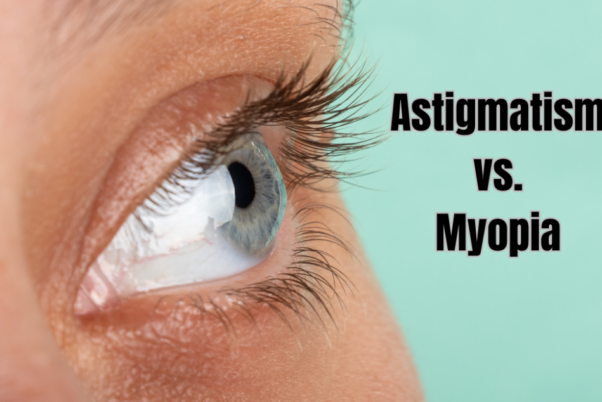Astigmatism vs. Myopia: What’s the Difference?
If you’ve ever squinted to read a sign from afar or felt frustrated trying to bring blurry text into focus, you’re not alone. Astigmatism and myopia (commonly known as nearsightedness) are two of the most common vision problems people face today. But what’s the difference? Let’s dive in and clear things up.

Understanding Astigmatism
Astigmatism is a unique refractive error that impacts how your eye focuses light. In a perfectly shaped eye, the cornea or lens has a round, soccer-ball-like shape. However, if you have astigmatism, the curvature of the cornea or lens is more like a football, causing light to scatter instead of focusing neatly on the retina. This results in distorted or blurred vision at all distances.
Common symptoms of astigmatism include:
- Blurry vision
- Eye strain
- Headaches
- Difficulty seeing at night
Astigmatism can vary in severity, with some people experiencing minor astigmatism that may not require correction, while others need glasses or contacts to see clearly. The good news? Astigmatism can be easily diagnosed during a comprehensive eye exam, and there are several treatment options available to correct astigmatism, from glasses to contact lenses and even laser surgery.
Understanding Myopia (Nearsightedness)
Myopia occurs when the eye is elongated, causing light to focus in front of the retina rather than directly on it. This condition, commonly known as nearsightedness, makes distant objects appear blurry while close-up tasks like reading remain clear. Myopia often develops during childhood and can progress over time, especially if left unmanaged.
Key symptoms of myopia include:
- Difficulty seeing distant objects
- Squinting
- Eye strain
- Headaches
Myopia can be diagnosed with a simple eye exam, where an eye doctor will assess how light enters your eye and whether it focuses properly on the retina. Correcting myopia is straightforward, with options ranging from glasses and contact lenses to more permanent solutions like LASIK surgery.
Astigmatism vs. Myopia: What’s the Difference?
While both astigmatism and myopia affect your vision, they do so in different ways. Astigmatism is caused by an irregularly shaped cornea or lens, leading to distorted vision at all distances. Myopia, on the other hand, is a result of an elongated eyeball that causes distant objects to appear blurry.
Here’s a quick comparison:
- Astigmatism: Causes blurred or distorted vision at any distance, often due to an irregular cornea or lens shape.
- Myopia: Causes distant objects to appear blurry because the eyeball is longer than normal.
Both conditions are refractive errors, meaning they affect how light is focused in your eye. They can also occur together, making it crucial to get regular eye exams to ensure you have the correct vision correction for both conditions.
Similarities Between Astigmatism and Myopia
Despite their differences, astigmatism and myopia share a few commonalities. Both conditions:
- Can cause headaches and eye strain
- Require corrective lenses or surgery for clear vision
- Are easily diagnosed during a comprehensive eye exam
Additionally, both conditions can progress over time if left unchecked. That’s why it’s essential to keep up with regular eye exams to monitor your eye health and adjust your prescription as needed.

Treatment Options for Astigmatism and Myopia
At Poudre Valley Eyecare, we offer a range of treatment options to correct astigmatism and myopia. These include:
- Glasses: The most common and straightforward solution. We work closely with Eyemart to provide high-quality lenses tailored to your prescription.
- Contact Lenses: Ideal for those who prefer not to wear glasses. Our optometrists will help find the best fit based on your eye shape and vision needs.
- LASIK Surgery: For those looking for a more permanent solution, we co-manage LASIK procedures with top surgeons in the area to ensure optimal outcomes.
- Ortho-K Lenses: These specialized lenses reshape your cornea overnight, providing clear vision during the day without the need for glasses or contacts.
Prevention & Early Intervention
Protect Your Vision: Proactive Tips for Fort Collins Families
Astigmatism and myopia can’t always be prevented, but early intervention helps slow progression and protect long-term eye health. Here’s how Fort Collins residents can stay ahead:
Risk Factors to Watch
- Genetics: A family history of myopia or astigmatism increases risk.
- Screen Time: Remote workers at CSU or local tech hubs should follow the 20-20-20 rule (every 20 minutes, look 20 feet away for 20 seconds).
- Outdoor Time: Studies show kids who play outdoors 1–2 hours daily have a lower myopia risk. Explore Fort Collins’ parks, like City Park or Spring Canyon, to balance screen use.
Early Detection in Fort Collins
- Pediatric Eye Exams: Schedule by age 3, especially if your child squints or sits close to screens.
- School Screenings: Poudre Valley Eyecare partners with Poudre School District for free vision checks.
- Lifestyle Adjustments:
- Ensure homework areas have bright, natural light (avoid dim coffee shops like The Bean Cycle).
- Limit handheld devices before bedtime to reduce eye strain.
Living with Astigmatism & Myopia
Thriving in Fort Collins: Daily Tips for Clear Vision
Living with astigmatism or myopia doesn’t mean missing out on Fort Collins’ active lifestyle. Here’s how to adapt:
Overcoming Common Challenges
- Night Driving: Astigmatism glare worsens on dim roads like Riverside Avenue. Try anti-glare lenses or yellow-tinted glasses.
- Outdoor Adventures: For hiking Horsetooth Reservoir or biking the Poudre Trail, opt for wraparound sunglasses with UV400 protection.
- Screen Use: Remote workers at Woodward or HP benefit from blue-light-blocking lenses.
Pro Tips for Active Lifestyles
- Sports: Choose impact-resistant polycarbonate lenses for soccer at Fort Collins Soccer Club.
- Studying: CSU students love lightweight glasses with anti-fatigue lenses for library marathons.
- Winter: Anti-fog coatings prevent blurry vision during snowy walks in Old Town.
Conclusion
Whether you’re squinting to see distant objects or struggling with blurry vision at any distance, it’s important to understand the differences between astigmatism and myopia. Both are common eye conditions that can be easily managed with the right care and treatment.
At Poudre Valley Eyecare, our focus is you. We’re committed to providing the best eye care in Fort Collins, using the latest technology to diagnose and treat your vision problems. If you’re experiencing symptoms of astigmatism or myopia, don’t hesitate to schedule a comprehensive eye exam with us today. Clear vision is just an appointment away.
Astigmatism vs. Myopia FAQs
-
What is the difference between astigmatism and myopia?
Astigmatism and myopia are two types of refractive errors that affect vision. Myopia, or nearsightedness, occurs when the eye is too long or the cornea is too curved, causing distant objects to appear blurry. Astigmatism, on the other hand, is caused by an irregular shape of the cornea or lens, leading to distorted or blurry vision at any distance.
-
How can an eye exam help in diagnosing myopia and astigmatism?
-
Can myopia and astigmatism occur together?
-
What are the common symptoms of astigmatism and myopia?
-
How is managing myopia different from treating astigmatism?
-
What role does the shape of the eye play in astigmatism and myopia?
-
Can degenerative myopia worsen over time?
-
How can I tell if I have astigmatism or myopia?
-
Are there specific treatments for high myopia compared to astigmatism?
Our website and online content are for informational purposes only and should not be considered personalized medical advice. Please book an appointment if you’d like personalized advice from a medical professional.
Dr. Eric Torgerson
Owner at Poudre Valley Eyecare
Dr. Eric Torgerson is the owner of Poudre Valley Eyecare, and has been recognized for his contributions to optometry and his commitment to community health through various roles and accolades within the Northern Colorado Optometric Society and the Colorado Optometric Association.
Why Choose Us?
Our advanced technology and individualized care deliver results for patients of all ages. Our routine exams allow us to spot changes in your vision and allow us to treat those changes early. We have a comprehensive understanding of eye care, which means we can treat a wide range of conditions and chronic diseases. Our in-depth routine exams and customized treatment plans set us apart from the rest.




